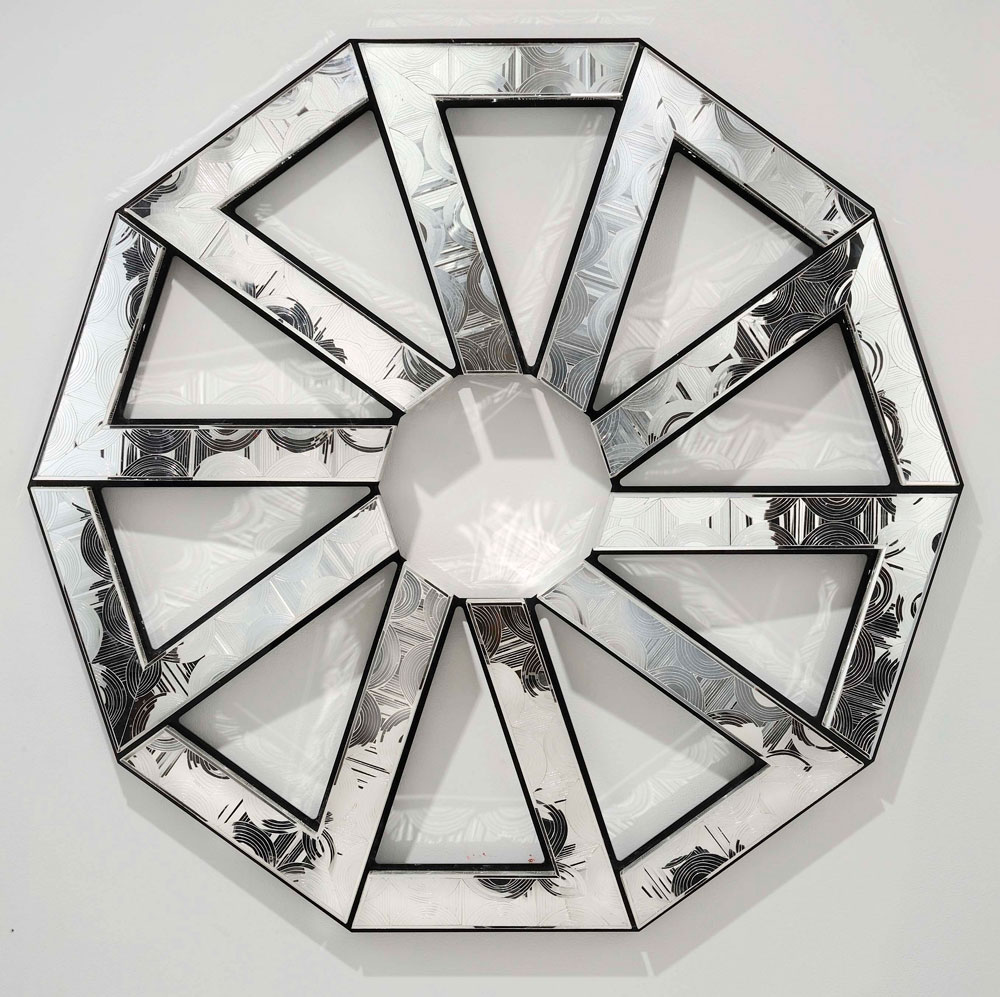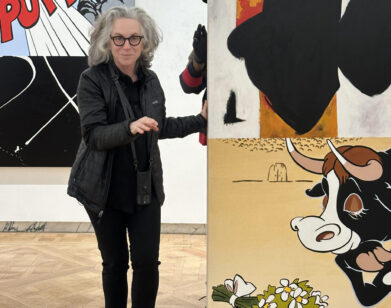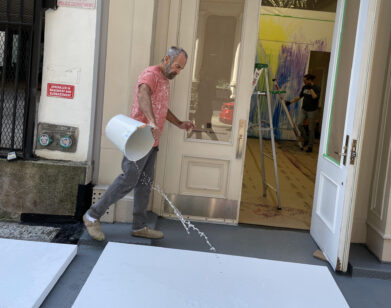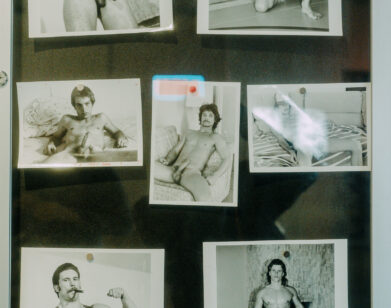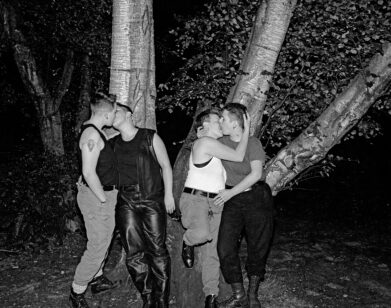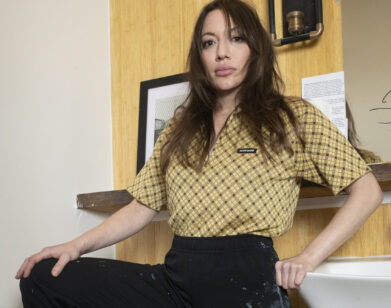Mirroring Monir
At the age of 91 and considered one of the most important Iranian figures of contemporary art, artist Monir Shahroudy Farmanfarmaian is just now receiving her first comprehensive exhibition in the United States at the Guggenheim Museum. Beginning in the 1950s, Farmanfarmaian’s breadth of work ranges from floral drawings to geometric faceted mirror sculptures, collages, and what she terms “memory boxes.” She frequently merges traditional Persian architectural and decorative elements (including the simplicity of form and eloquent ornamentation), the repetition of Islamic patterns, and Sufi cosmology with modern practices of Western abstraction.
Although her practice spans more than 60 years, the exhibition at the Guggenheim focuses on the artist’s mirror works and drawings made between 1974 and 2014—after her return to New York in efforts to escape the Iranian Revolution. Farmanfarmaian studied at the University of Tehran, before moving to New York, where she attended Cornell and Parsons, and fell into a circle of friends that included Jackson Pollock, Willem de Kooning, Barnett Newman, and Andy Warhol. The book, Monir: Works on Paper, has been published to coincide with the exhibition, and features discussions between the artist and Hans-Ulrich Obrist and Frank Stella.
Before an intimate reception with friends and family, Farmanfarmaian spoke with Hans-Ulrich Obrist over sparkling rosé and vodka, shedding light on topics that even the Swiss curator, critic, and historian didn’t know himself.
HANS-ULRICH OBRIST: It is wonderful to do an interview for Interview, because it is a tautology. Given Interview’s history, it would be great to start with your first arrival in New York.
MONIR SHAHROUDY FARMANFARMAIAN: I think it was in 1945 and it was March, because the Iranian ambassador had a party for the Persian-Iranian New Years. I was invited to that party and it was on the 21st of March. It was perfect. Coming from Tehran, I was on the way for three months. It was a long trip to New York.
OBRIST: Who were the first people here that you met in the art world? How did you come to art?
FARMANFARMAIAN: When I came [to America] a gentleman, Arthur Pope—I’m sure you’ve heard his name because he published six volumes on Iranian history and architecture—introduced me to a lady, Barbara. Barbara was my godmother, almost. She put me in high school to learn English, which I had never learned, and after that, put me in Cornell University. I said, “Cornell is not very modern for painting and drawing,” so she brought me to New York to Parsons School of Design.
OBRIST: Then, again in relation to Interview, can you tell me how you met Andy Warhol?
FARMANFARMAIAN: That is long ago! Andy Warhol was in 1950. When I graduated from Parsons, I was doing commercial art. Commercial art was very disappointing. I carried my portfolio from one agency to another. Some people said, “Your artwork is so highly beautiful, we cannot use it.” Others said, “No, no. It’s so bad. We cannot use it.” [both laugh] I had a friend who was a writer [and] he had a friend who was working for Bonwit Teller, so he introduced me to the director of the advertising department and they hired me as the layout artist. Andy Warhol at that time was doing shoe drawing for us. I would make a page of tabs—this one here, that one there, text should be here, and text should be there—and I would give it to Andy and Andy would finish it up very beautifully, the drawing.
Later on, in 1975, 1978, my daughter brought him to Tehran to do the portrait of the king and queen. I saw him in London before, and I said, “Andy I want to have your Marilyn Monroe on silver, but I cannot find it in the galleries to buy.” So when he came to Iran, he brought me that as a present: Marilyn Monroe silkscreen on silver. And he gave me many shoe and flower drawings. But unfortunately, when the revolution came, they confiscated my house and whatever I had of the books, drawings, clothing, antiques, and whatnot. They took it away. I don’t know where they are now. It’s a sad story, but true.
OBRIST: Also Andy has this famous mirror ball of yours. What’s the story of this piece?
FARMANFARMAIAN: He came to my home for lunch, dinner, and so on, with my daughter. So he came to my studio, which was in the same house that I was living in. He came there [and] I gave one of my crystal balls to him. He had it in his living room on his table. Whenever I saw Andy, he would say, “Monir, I have your ball with me everyday.” I said, “I don’t have a ball!” [laughs] And we would both laugh.
OBRIST: What prompted you to do these mirror spheres?
FARMANFARMAIAN: I was doing mirror work and then one day I was going to some historical place, and I saw kids there, playing football with this plastic ball. I said, “It’s good to make this plastic ball with mirrors,” so I bought 10 or five, and I started to make it into a crystal ball.
OBRIST: It would be nice if you [could] tell us a little bit about what prompted you to work with mirror? It’s such an important part of your work. Even in the drawings, you use fragments of mirrors.
FARMANFARMAIAN: This is my imagination. Mirror is so beautiful to me. When I went to mosque in Shiraz and palaces, I saw they had wall-to-wall mirrors, I said, “How wonderful it would be if I could bring a piece of that into people’s houses and living rooms,” so I started doing mirror works that way. First I was doing my own design and cutting the mirror and painting behind the glass, which was done 200 years ago by Russians and Iranians—flowers, portraits, things like that. I did that in a very abstract way, mixed it with mirror, and then I became aware of geometry. Today, I find that geometry has meaning from the start. It goes from triangle, to square, pentagon, hexagon, all the way up to 12, which is the zodiac—the 12 months of the year.
OBRIST: I was wondering if you could tell us a about how you came to this hexagon idea, because the hexagon is something that kept you involved for many decades…
FARMANFARMAIAN: Dear Hans, I had a star, a master, of mirror work. He worked for 35 [years] cutting mirror and making palaces. I said, “How do you mix this pattern with another pattern?” And he said, “The base of it is hexagons. A hexagon can go in unlimited different mixtures of design.” Geometry has many different possibilities to create unlimited designs. Pentagons can’t do it, but hexagons can create unlimited designs.
OBRIST: So that’s the cobblestone of geometry. It’s interesting that more recently in 2014 and 2015, you did a lot of drawings with the felt marker on paper, which are very free, geometric drawings. They also have more dimensions; they go into the nonagon. Can you tell us a little bit about this?
FARMANFARMAIAN: I love the nonagon. [laughs]
OBRIST: It’s like an eruption! Your work is so incredible, these recent drawings. It would be good to hear a little bit about them.
FARMANFARMAIAN: I like these drawings. It’s a continuation of my early drawings in geometry. I don’t like to repeat. I like to find new things.
OBRIST: The book also includes many unexpected drawings that are not geometric, for example, your flower drawings, which you did in the ’70s. We talked about Andy Warhol’s flower drawings, but you also did flower drawings.
FARMANFARMAIAN: Oh, I did a lot with flowers. The last one I did was with a Chinese brush, five-inches width. I bought the flower, put it on the coffee table, and I would look at it, observe it. I learned that from a Chinese artist. This man would study a mountain for a month, and another month, and a year, and didn’t do anything. Then he got first prize and when asked “how come,” he said, “Because I observed nature. Then I did the drawing.” That is the reason it became so popular. I did the same thing. I looked at the flower in the evening and then the next morning, I took the big brush, dipped in the ink, and then wipe it like whoop-zoop-zoo-zooop! I’m finished.
OBRIST: After your arrival in New York, in ’45, you returned to Iran. But then the Iranian revolution forced you to a second New York exile, when you started to do collage and memory boxes. I was wondering if you could tell us a little bit about your second exile in New York?
FARMANFARMAIAN: I had no studio. I had not much money. I have to earn money. So I would do this small work in the apartment. That was very sad, but at the same time profitable. I did memory boxes, which I call heartache, because it’s very nostalgic. I miss Iran. I put a picture of it, I put a piece of jewelry, in those memory boxes.
OBRIST: In German, we call it heimweh—a longing for home.
FARMANFARMAIAN: That’s right. Each of them have a lot of meaning. For instance, I have two, three boxes that were made out of the fabric my mother used to wear and use. It was leftover and she gave it to me.
OBRIST: At that same period, you also worked a lot with collages.
FARMANFARMAIAN: No, the collage has a completely different story. We bought an apartment on 5th Avenue. It was a penthouse and they were repairing the terrace. So I was all by myself doing nothing, but at the same time I couldn’t leave the apartment with three or four workers, so I sat there and watched. Once I was watching, they were putting a net over the black asphalt. It was so beautiful. I said, “Can I have a piece of your net?” He said, “Yes, by all means.” He cut it and gave it to me. I had cardboard, which was from my husband’s shirts—I used to give it to Chinese laundry—and then I had some pieces of newspaper, magazine. I used this and put the net over it. That was my first net collage.
Then a lady was doing the Saudi Arabia airport art pieces. She called me and said, “I would like to come to see you.” I said, “I don’t have anything in my house of my artwork. I’m an immigrant. I just arrived here with nothing.” She said, “No, no, no. I have seen your show at [Galerie] Denise Rene and I love your work. I want to come to meet you.” I said, “I am not able to do any art because I’m just arriving in this apartment.” When she came, I had this little collage I had made with the net of the workers. I said, “This is the only thing I have done now.” She said, “I love it! I love it! Can you do this in 9.5-foot…?”
OBRIST: So it was about making it big.
FARMANFARMAIAN: Huge! Then I said, “I don’t have a studio! I don’t have the material!” She said, “Think about it.” So I talked to my friend, the photographer and very famous artist, Lucas Samaras, I said, “Lucas, look! They asked me to do this. How could I do this?” He said, “Don’t be silly, Monir. Go to the lumberyard and buy two doors. Then, you don’t use your dining room; you don’t have parties. Make your dining room [into a studio], put these doors over [the table], and I will order some wood for the canvas. I’ll order two of them.” I say, “Why two? I don’t know even how to handle one!” He said, “If one doesn’t come out right, you have the second canvas and the wood ready.” He did it nicely and I made the collage and it came out very, very strong and beautiful. It was huge.
OBRIST: Is it still there, Monir? Does it still exist?
FARMANFARMAIAN: It is at the airport of Jeddah, in Saudi Arabia. I have a photo of it.
OBRIST: That’s a rarely known work.
FARMANFARMAIAN: That was very successful. The paid me $21,000 and that was a lot of money for me at that time, for my art. So that was the first collage and after that I did many collages.
OBRIST: You also did many more drawings, about music, for example. You showed them to me in Dubai when we worked on the book. Can you tell us about these [Vince] Guaraldi drawings?
FARMANFARMAIAN: After Guaraldi I came to John Cage. I love John Cage’s music.
OBRIST: How do you do them? Do you listen to the music and make the drawings?
FARMANFARMAIAN: No, dear. I’m sitting doing nothing. I don’t have a studio. I have magic marker and a pad of paper, so I thought I would play around with this.
OBRIST: Another idea of play, where you play around, are the honey bee drawings. I love the honey bee drawings. How did this invention come to you in ’78?
FARMANFARMAIAN: I love these bee drawings. At the Caspian—Caspian is very damp, very humid—it was cold outside and warm inside, and the window was full of a layer of fog. One bee sat on it and started to walk around. The footprint of that bee was so beautiful in the window, I said, “Why shouldn’t I use the bee drawing?”
When I went back to Tehran I got a big pad of paper and ink and I told to my gardener, “Catch me a bee.” He said, “What do you want a bee for?” I said, “I’d like to have a bee for a pet.” So I got the bee, got tweezers, then held the wings with the tweezers, and put the legs in the ink, and put it on the paper. It started to walk around and it was so beautiful. Then I got a bigger bee. The bees, I washed them with water, put them on the floor, and put honey and sugar and dates that they can eat, and then they worked the next day for me. [laughs]
OBRIST: The bees brought chance into the drawings, like John Cage. It’s like drawings of choreography. It makes me think of Merce Cunningham’s drawings of choreography, no? He showed me his drawings when I met him many years ago. He was 103 years old.
FARMANFARMAIAN: I’m 91, and now, half of my life I’ve lived in New York. I love New York. As a student, I never wanted to go out of New York, to Queens or to Brooklyn or to any place. Manhattan was only my place. [laughs]
OBRIST: Then you decided to leave again to Tehran to open your workshop. What prompted that? That was a very radical decision.
FARMANFARMAIAN: Because in 2004 the Museum of Contemporary Art in Tehran invited me to show at the museum and said, “You can invite two friends, too.” So I invited Frank Stella and Siah Armajani, and the three of us went to Tehran to have an exhibition. We rented a space for my studio [in Tehran] to work on it.
OBRIST: To come back to Warhol, that was your own factory.
FARMANFARMAIAN: I had a lot of workers. Then I had the Australia [commission], which was a two-square-meter wall. I had seven or eight workers, craftsmen, doing the mirror. But I designed it and made the painting behind the glass and all of that… That’s enough. [laughs]
OBRIST: Thank you so much. Always when we do interviews, Monir, you tell me new things. You never told me about the airport. This would’ve made Andy very happy.
One last question, Monir. What would be your advice to a young artist in 2015?
FARMANFARMAIAN: Not to be disappointed in life, to go ahead with your art. I had so much tragedy, losing all my house and so on, but I kept working.
“MONIR SHAHROUDY FARMANFARMAIAN: INFINITE POSSIBILITY. MIRROR WORKS AND DRAWINGS 1972-2014” IS ON VIEW AT THE GUGGENHEIM MUSEUM IN NEW YORK UNTIL JUNE 3. MONIR: WORKS ON PAPER IS AVAILABLE TO PURCHASE HERE.

